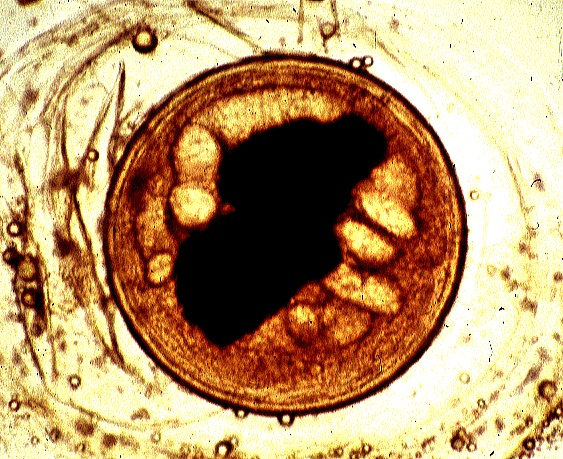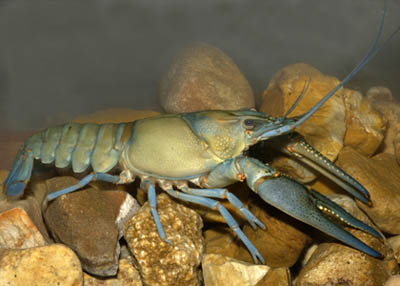Continuing the weird-things-people-do-with-food theme, doctors are warning people not to eat raw crayfish.
Physicians at Washington University School of Medicine in St. Louis have  diagnosed a rare parasitic infection in six people who had consumed raw crayfish from streams and rivers in Missouri. The cases occurred over the past three years, but three have been diagnosed since last September; the latest in April. Before these six, only seven such cases had ever been reported in North America, where the parasite, Paragonimus kellicotti, is common in crayfish.
diagnosed a rare parasitic infection in six people who had consumed raw crayfish from streams and rivers in Missouri. The cases occurred over the past three years, but three have been diagnosed since last September; the latest in April. Before these six, only seven such cases had ever been reported in North America, where the parasite, Paragonimus kellicotti, is common in crayfish.
"The infection, called paragonimiasis, is very rare, so it’s extremely unusual to see this many cases in one medical center in a relatively short period of time," says Washington University infectious diseases specialist Gary Weil, MD, professor of medicine and of molecular microbiology, who treated some of the patients. "We are almost certain there are other people out there with the infection who haven’t been diagnosed. That’s why we want to get the word out."
Paragonimiasis causes fever, cough, chest pain, shortness of breath and extreme fatigue. The infection is generally not fatal, and it is easily treated if properly diagnosed. But the illness is so unusual that most doctors are not aware of it.
The half-inch, oval-shaped parasitic worms at the root of the infection primarily travel from the intestine to the lungs. They also can migrate to the brain, causing severe headaches or vision problems, or under the skin, appearing as small, moving nodules.
The recent infections, which occurred in patients ages 10-32, have prompted the Missouri Department of Health & Senior Services to issue a health advisory alerting doctors across the state. The department also printed posters warning people not to eat raw crayfish and placed them in  campgrounds and canoe rental businesses near popular Missouri streams. Thoroughly cooking crayfish kills the parasite and does not pose a health risk.
campgrounds and canoe rental businesses near popular Missouri streams. Thoroughly cooking crayfish kills the parasite and does not pose a health risk.
Paragonimiasis is far more common in East Asia, where many thousands of cases are diagnosed annually in people who consume raw or undercooked crab that contain Paragonimus westermani, a cousin to the parasite in North American crayfish.
The crayfish is the State Invertebrate of Missouri. I’m not making this up.

 again.
again. It would be useful if the strain of E. coli was provided in future public announcements.
It would be useful if the strain of E. coli was provided in future public announcements. We never plan these things because we’re both busy – Jorge in his crisp, tailored suit, talking about all the meals
We never plan these things because we’re both busy – Jorge in his crisp, tailored suit, talking about all the meals  head cheese isn’t cooked, the bacteria stays in the product.
head cheese isn’t cooked, the bacteria stays in the product. During a drive to Kansas City, MO I remember Doug telling me about the abundance of methamphetamine labs in the Midwest, and to keep an eye out for stray bathtubs on the side of the highway – I guess that’s where the meth is made.
During a drive to Kansas City, MO I remember Doug telling me about the abundance of methamphetamine labs in the Midwest, and to keep an eye out for stray bathtubs on the side of the highway – I guess that’s where the meth is made. Like the barf poetry crowd.
Like the barf poetry crowd. A retrospective cohort study, conducted through self-administered questionnaires among approximately 3,000 students and teachers who had participated in two meals in 36 schools concerned, was initiated to confirm the existence of a foodborne outbreak and its origin. …
A retrospective cohort study, conducted through self-administered questionnaires among approximately 3,000 students and teachers who had participated in two meals in 36 schools concerned, was initiated to confirm the existence of a foodborne outbreak and its origin. …  But we drank it.
But we drank it. (1).jpg) As a father with four daughters and a fifth on the way, I relate to the let’s not make kids sick aspect of raw milk.
As a father with four daughters and a fifth on the way, I relate to the let’s not make kids sick aspect of raw milk.